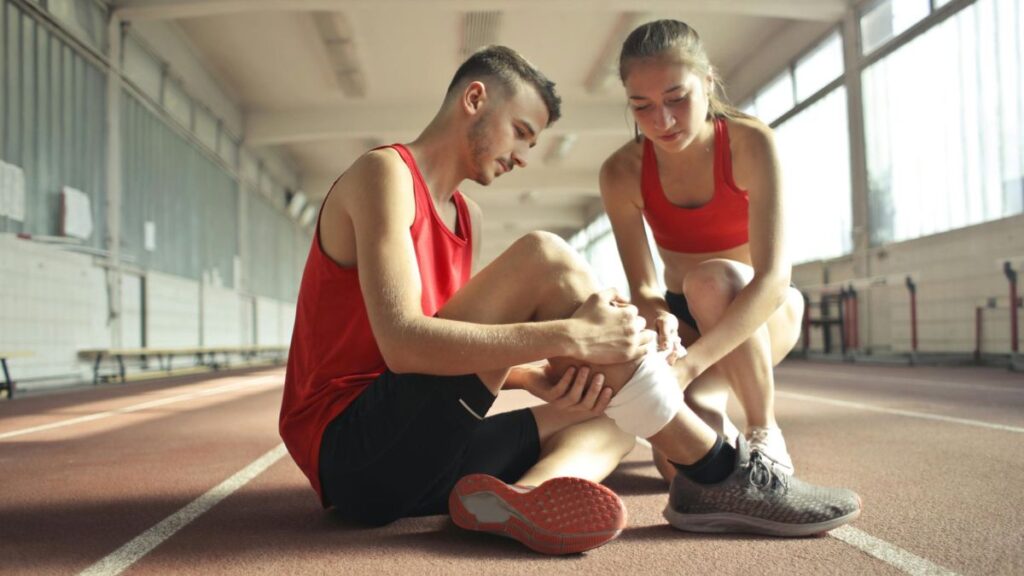Athletic activities bring joy and fitness but can lead to injuries, from minor sprains to serious conditions requiring rehab. Millions are affected annually, but most sports injuries are preventable. With proper care, athletes can recover and return stronger. This guide covers prevention, treatment, and recovery essentials.
Common Sports Injuries: What Athletes Face Most
Sports injuries typically fall into two categories: acute injuries that happen suddenly during activity, and overuse injuries that develop gradually over time.
Acute injuries include sprains (ligament tears), strains (muscle or tendon tears), fractures, and dislocations. These often result from direct impact, sudden movements, or falls. Ankle sprains top the list as the most common acute injury across all sports.
Overuse injuries develop when repetitive stress overwhelms the body’s ability to repair itself. Tennis elbow, runner’s knee, and stress fractures are prime examples. These injuries often start as minor discomfort but can become debilitating if ignored.
Understanding these injury patterns helps athletes recognize early warning signs and take appropriate action before minor issues become major problems.
Prevention: Your First Line of Defense
The most effective treatment for sports injuries is preventing them in the first place. A comprehensive prevention strategy involves several key components.
Proper Warm-Up and Cool-Down
A good warm-up gradually increases heart rate and blood flow to muscles, preparing your body for more intense activity. Spend 10-15 minutes on light cardiovascular exercise followed by dynamic stretches that mimic movements from your sport.
Cool-down periods are equally important. Gentle stretching and light movement help remove metabolic waste products from muscles and begin the recovery process.
Stretching and Flexibility Training
Regular stretching improves range of motion and muscle elasticity, reducing injury risk. Focus on both static stretches (holding positions for 30 seconds) and dynamic movements that prepare muscles for sport-specific actions.
Equipment and Environment
Wearing proper protective gear significantly reduces injury risk. This includes sport-appropriate footwear, helmets, padding, and protective eyewear when necessary. Regular equipment inspection ensures everything functions correctly when needed most.
Playing surfaces also matter. Uneven fields, poor lighting, and inappropriate weather conditions all increase injury risk. When possible, choose well-maintained facilities and avoid playing in dangerous conditions.
Immediate Injury Care: The RICE Method
When an acute injury occurs, quick and appropriate response can significantly impact recovery time and outcomes. The RICE method provides a simple framework for immediate care:
Rest: Stop the activity immediately to prevent further damage. Continuing to play through pain often transforms minor injuries into major ones.
Ice: Apply ice for 15-20 minutes every 2-3 hours during the first 48 hours. Cold therapy reduces swelling and numbs pain. Never apply ice directly to skin—always use a cloth barrier.
Compression: Elastic bandages or compression garments help control swelling and provide support. Apply compression firmly but not so tight that it restricts blood flow.
Elevation: Raise the injured area above heart level when possible. This uses gravity to help reduce fluid accumulation and swelling.
For severe injuries involving suspected fractures, head trauma, or loss of consciousness, seek immediate medical attention rather than attempting self-treatment.
Rehabilitation and Physical Therapy
Once the initial healing phase passes, rehabilitation becomes crucial for complete recovery. Physical therapy helps restore strength, flexibility, and function while preventing future injuries.
A structured rehabilitation program typically progresses through several phases. The acute phase focuses on pain and swelling control. The recovery phase emphasizes restoring normal movement patterns and gradually increasing activity levels. The functional phase prepares athletes for return to sport-specific activities.
Professional guidance during rehabilitation is invaluable. A holistic chiropractor, such as those in Ionia, can provide comprehensive treatment that addresses not just the injury site but contributing factors throughout the body. Physical therapists develop personalized exercise programs that target specific deficits and movement dysfunctions.
Nutrition’s Role in Recovery
Proper nutrition accelerates healing and supports tissue repair. During recovery, the body’s nutritional needs increase significantly.
Protein provides building blocks for tissue repair. Aim for 1.2-2.0 grams per kilogram of body weight daily, emphasizing high-quality sources like lean meats, fish, eggs, and legumes.
Anti-inflammatory foods can help reduce tissue inflammation. Fatty fish, leafy greens, berries, and nuts contain compounds that support the healing process.
Adequate calories ensure the body has energy for repair processes. Severe calorie restriction during injury recovery can significantly slow healing.
Hydration remains crucial even during reduced activity periods. Water supports cellular function and nutrient transport throughout the body.
Consider consulting with a sports nutritionist to develop a recovery-specific eating plan that meets your individual needs and preferences.
Mental Health and Recovery Psychology
The psychological impact of sports injuries often receives less attention than physical healing, but mental health plays a crucial role in recovery outcomes.
Many athletes experience frustration, anxiety, or depression following injury, especially when it affects their ability to participate in activities they love. Fear of re-injury can persist even after physical healing is complete.
Developing coping strategies helps maintain mental health during recovery. Setting realistic goals, maintaining social connections, and finding alternative activities can prevent isolation and depression.
Sports psychology techniques like visualization and relaxation training can actually accelerate physical healing while preparing athletes mentally for return to competition.
When to Seek Professional Help
While minor injuries often respond well to home treatment, certain situations require professional medical evaluation:
- Severe pain that doesn’t improve with rest and basic care
- Inability to bear weight or use the injured area normally
- Numbness, tingling, or loss of sensation
- Signs of infection like increased warmth, redness, or fever
- Injuries that don’t show improvement within a few days
Early professional intervention often prevents minor injuries from becoming chronic problems that require extensive treatment later.
Safe Return to Sport Guidelines
Returning to activity too quickly is one of the leading causes of re-injury. A gradual, systematic approach ensures the body is truly ready for sport demands.
The return-to-play process typically follows a progressive pattern: rest, light activity, sport-specific movements, non-contact practice, full contact practice, and finally competition.
Each phase should be completed without pain or significant symptoms before progressing to the next level. This process may take days, weeks, or months depending on the injury severity and individual healing rates.
Functional testing can help determine readiness for return. This might include strength measurements, balance tests, or sport-specific movement assessments that ensure the injured area can handle competitive demands.
Conclusion
Now that you have a better understanding of the stages of injury rehabilitation, it is important to remember that patience and consistency are key during this process. It may be frustrating at times, but rushing through the phases or returning to activity too soon can lead to reinjury.






